Middle-Late Eocene Climate in the Pearl River Mouth Basin: Evidence from a Palynological and Geological Element Record in the Xijiang Main Subsag
Abstract
:1. Introduction
2. Regional Geological Background
3. Samples and Experimental Methods
4. Results and Interpretation
4.1. Pollen Band Characteristics
4.1.1. Pollen Zone I
4.1.2. Pollen Zone II
4.1.3. Pollen Zone III
4.2. Element Geochemical Characteristics
5. Stratigraphic Age Significance of Palynofloras
6. Middle-Late Eocene Climate Reconstruction
6.1. Palaeoclimate Indication from Palynology
6.2. Palaeoclimate Indications from Elemental Geochemistry
7. Middle-Late Eocene Climate Records and Global Climate Evolution
8. Conclusions
- A total of 73 genera and 115 species of sporopollen fossils were identified in the Wenchang–Enping Formations, including 37 genera of angiosperms, 20 genera of ferns, and 16 genera of gymnosperms. Palynoflora analysis showed that the Wenchang Formation–Enping Formation could be dated to the middle-late Eocene;
- The analysis of vegetation type, air temperature type, and the degree of sporopollen dryness and wetness in the target layer of the study area showed that climate zone I mainly had a subtropical–warm temperate palaeoclimate, climate zone II had a temperate palaeoclimate, and climate zone III had a warm temperate palaeoclimate. The palaeoclimate reconstruction results for the element geochemical indicators (Fe/Mn, Sr/Cu, CIA, PIA, etc.) were basically consistent with the palaeoclimatic evolution indicated by palynology;
- The climate of the middle-late Eocene in the study area showed a transition from a warm and humid climate to a warm and cool semihumid–semiarid climate and then to a warm and cool semihumid climate, demonstrating a good coupling relationship with the trend for the changes in the global temperature.
Author Contributions
Funding
Data Availability Statement
Acknowledgments
Conflicts of Interest
References
- Miller, K.G.; Fairbanks, R.; Mountain, G.S. Tertiary oxygen isotope synthesis, sea level history, and continental margin erosion. Paleoceanography 1987, 2, 1–19. [Google Scholar] [CrossRef]
- Thomas, E.; Zachos, J.C. Was the late Paleocene thermal maximum a unique event? GFF 2000, 122, 169–170. [Google Scholar] [CrossRef]
- Abels, H.A.; Clyde, W.C.; Gingerich, P.D. Terrestrial carbon isotope excursions and biotic change during Palaeogene hyperthermals. Nat. Geosci. 2012, 5, 326–329. [Google Scholar] [CrossRef]
- Crouch, E.M.; Shepherd, C.L.; Morgans, H.E.G. Climatic and environmental changes across the early Eocene climatic optimum at mid-Waipara River, Canterbury Basin, New Zealand. Earth-Sci. Rev. 2020, 200, 102961. [Google Scholar] [CrossRef]
- Chen, Z.L.; Ding, Z.L. A review on the Paleocene-Eocene Thermal Maximum. Quat. Sci. 2011, 31, 937–950. [Google Scholar]
- Zachos, J.C.; Dickens, G.R.; Zeebe, R.E. An early Cenozoic perspective on greenhouse warming and carbon-cycle dynamics. Nature 2008, 451, 279–283. [Google Scholar] [CrossRef] [Green Version]
- Westerhold, T.; Röhl, U.; Frederichs, T. Astronomical calibration of the Ypresian timescale: Implications for seafloor spreading rates and the chaotic behavior of the solar system? Clim. Past 2017, 13, 1129–1152. [Google Scholar] [CrossRef] [Green Version]
- Korasidis, V.A.; Wallace, M.W.; Wagstaff, B.E. Terrestrial cooling record through the Eocene-Oligocene transition of Australia. Glob. Planet. Chang. 2019, 173, 61–72. [Google Scholar] [CrossRef]
- Teng, X.H.; Wang, C.L.; Shen, L.J.; Wang, J.Y.; Yu, X.C.; Liu, X. Paleoclimate during the Paleocene–Eocene Extreme Thermal Event Recorded by the Deep Drill Core SKD1 in the Jianghan Basin. Acta Geosci. Sin. 2022, 43, 65–72. [Google Scholar]
- Chen, Z.L.; Ding, Z.L.; Tang, Z.H. Early Eocene carbon isotope excursions: Evidence from the terrestrial coal seam in the Fushun Basin, Northeast China. Geophys. Res. Lett. 2014, 5, 326–329. [Google Scholar] [CrossRef]
- Chen, Z.L. Carbon-cycle dynamics during the Paleocene-Eocene Thermal Maximum. Chin. Sci. Bull. 2022, 67, 1704–1714. [Google Scholar] [CrossRef]
- Mosbrugger, V.; Utescher, T.; Dilcher, D.L. Cenozoic continental climatic evolution of Central Europe. Proc. Natl. Acad. Sci. USA 2005, 102, 14964–14969. [Google Scholar] [CrossRef] [Green Version]
- Aleksandrova, G.N.; Kodrul, T.M.; Jin, J.H. Palynological and paleobotanical investigations of Paleogene sections in the Maoming Basin, South China. Stratigr. Geol. Correl. 2015, 23, 300–325. [Google Scholar] [CrossRef]
- Herman, A.B.; Spicer, R.A.; Aleksandrova, G.N. Eocene–early Oligocene climate and vegetation change in southern China: Evidence from the Maoming Basin. Palaeoecology 2017, 479, 126–137. [Google Scholar] [CrossRef] [Green Version]
- Wei, Y.; Yang, B.; Xia, H.D.; Deng, H.J. Paleovegetation and Paleoclimate during Mid-Late Eocene in Fushun Basin. Earth Sci. 2021, 46, 1848–1861. [Google Scholar]
- Wang, X.M.; Wang, M.Z.; Zhang, X.L. Palynology Assemblages and Paleoclimatic Character of the Late Eocene to the Early Oligocene in China. Earth Sci. 2005, 30, 309–316. [Google Scholar]
- Ding, W.J.; Hou, D.J.; Gan, J. Sedimentary geochemical records of late Miocene-early Pliocene palaeovegetation and palaeoclimate evolution in the Ying-Qiong Basin, South China Sea. Mar. Geol. 2022, 445, 106750. [Google Scholar] [CrossRef]
- Algeo, T.J.; Ingall, E. Sedimentary Corg:P ratios, paleocean ventilation, and Phanerozoic atmospheric pO2. Palaeoecology 2007, 256, 130–155. [Google Scholar] [CrossRef]
- Akinlua, A.; Adekola, S.A.; Swakamisa, O. Trace element characterisation of Cretaceous Orange Basin hydrocarbon source rocks. Appl. Geochem. 2010, 25, 1587–1595. [Google Scholar] [CrossRef]
- Yang, H.F.; Zhao, Y.; Cui, Q.Y.; Ren, W.H.; Li, Q. Paleoclimatic indication of X-ray fluorescence core-scanned Rb/Sr ratios: A case study in the Zoige Basin in the eastern Tibetan Plateau. Sci. Sin. (Terrae) 2021, 51, 73–91. [Google Scholar] [CrossRef]
- Xu, C.; Shan, X.L.; He, W.T.; Zhang, K.; Rexiti, Y.; Su, S.Y.; Liang, C.; Zou, X.T. The influence of paleoclimate and a marine transgression event on organic matter accumulation in lacustrine black shales from the Late Cretaceous, southern Songliao Basin, Northeast China. Int. J. Coal Geol. 2021, 246, 103842. [Google Scholar] [CrossRef]
- Nesbitt, H.W.; Young, G.M. Early Proterozoic climates and plate motions inferred from major element chemistry of lutites. Nature 1982, 299, 715–717. [Google Scholar] [CrossRef]
- Fedo, C.M.; Nesbitt, H.W.; Young, G.M. Unraveling the effects of potassium metasomatism in sedimentary rocks and paleosols, with implications for paleoweathering conditions and provenance. Geology 1995, 23, 921–924. [Google Scholar] [CrossRef]
- Xu, J.J. High Resolution Depiction of Organic Matter Accumulation Mechanism in the Upper Cretaceous Oil Shale of the Northern Songliao Basin (NE China). Master’s Thesis, Jilin University, Changchun, China, 16 December 2015. [Google Scholar]
- Li, W.P.; Li, H.L.; Wang, Y.; Liu, S.F.; Zhang, Z.P.; Yang, W.L.; Cai, X.R.; Qian, T.; Li, X.J. Neoproterozoic glaciations in Yecheng area, southwestern margin of the Tarim Basin. Earth Sci. Front. 2022, 29, 356–380. [Google Scholar]
- Zhang, K.; Liu, R.; Liu, Z.J.; Li, L. Geochemical characteristics and geological significance of humid climate events in the Middle-Late Triassic (Ladinian-Carnian) of the Ordos Basin, central China. Mar. Pet. Geol. 2021, 131, 105179. [Google Scholar] [CrossRef]
- Lu, C.Y. Paleoclimatic Change and Sedimentary Response of the Late Carboniferous-Early Permian in the Basin of Craton in North China Block: A case from the Western Shandong. Master’s Thesis, Shandong University of Science & Technology, Qingdao, China, 16 April 2019. [Google Scholar]
- Gupta, S.; Kumar, K. Precursors of the Paleocene–Eocene Thermal Maximum (PETM) in the Subathu Group, NW sub-Himalaya, India. J. Asian Earth Sci. 2019, 169, 21–46. [Google Scholar] [CrossRef]
- Sun, X.M.; Zhang, X.Q.; Zhang, G.C.; Lu, B.L.; Yue, J.P.; Zhang, B. Texture and tectonic attribute of Cenozoic basin basement in the northern South China Sea. Sci. Sin. (Terrae) 2014, 44, 1312–1323. [Google Scholar] [CrossRef]
- Xie, H.; Zhou, D.; Li, Y. Cenozoic tectonic subsidence in Deepwater sags in the Pearl River Mouth Basin, northern South China Sea. Tectonophysics 2014, 615–616, 182–198. [Google Scholar] [CrossRef]
- Shi, H.S.; Shu, Y.; Du, J.Y.; Zhu, J.Z. Petroleum Geology of Paleogene in Zhujiangkou Basin; Geology Press: Beijing, China, 2017. [Google Scholar]
- Liu, P.; Zhang, X.T.; Lin, H.M.; Du, J.Y.; Feng, J.; Chen, W.T.; Liao, J.; Jia, P.M. Distribution Mechanism of Oil and Gas in Xijiang Main Depression of Pearl River Mouth Basin. J. Jilin Univ. (Earth Sci. Ed.) 2021, 51, 52–64. [Google Scholar]
- Hu, Y.; Hao, F.; Zhu, J.Z. Origin and occurrence of crude oils in the Zhu1 sub-basin, Pearl River Mouth Basin, China. J. Asian Earth Sci. 2015, 97, 24–37. [Google Scholar] [CrossRef]
- Mi, L.J.; Zhang, X.T.; Chen, W.T.; Liu, P.; Du, J.Y.; Yao, J.L. Hydrocarbon enrichment law of Paleogene Zhu1 depression and its next exploration strategy in Pearl River Mouth basin. China Offshore Oil Gas 2018, 30, 1–13. [Google Scholar]
- Shi, H.S.; Zhang, X.T.; Chen, W.T.; Liu, P.; Du, J.Y.; Yao, J.L. Hydrocarbon geology, accumulation pattern and the next exploration strategy in the eastern Pearl River Mouth basin. China Offshore Oil Gas 2014, 26, 11–22. [Google Scholar]
- Zhao, F.; Alves, T.M.; Xia, S.H. Along-strike segmentation of the South China Sea margin imposed by inherited pre-rift basement structures. Earth Planet. Sci. Lett. 2020, 530, 115862. [Google Scholar] [CrossRef]
- Haq, B.U.; Hardenbol, J.; Vail, P.R. Chronology of fluctuating sea levels since the Triassic. Science 1987, 235, 1156–1167. [Google Scholar] [CrossRef] [Green Version]
- Li, Q.Y.; Cheng, X.Y.; Chen, J. Data report: Oligocene foraminifers and stable isotopes from IODP Hole U1435A. Proc. Integr. Ocean. Drill. Program 2008, 308, 1–5. [Google Scholar]
- Li, C.F.; Xu, X.; Lin, J.; Sun, Z.; Zhu, J.; Yao, Y.J.; Zhao, X.X. Ages and magnetic structures of the South China Sea constrained by deep tow magnetic surveys and IODP Expedition 349. Geochem. Geophys. Geosystems 2014, 15, 4958–4983. [Google Scholar] [CrossRef] [Green Version]
- Wang, P.X.; Jian, Z.M. Exploring the deep South China Sea: Retrospects and prospects. Sci. China Earth Sci. 2019, 62, 1473–1488. [Google Scholar] [CrossRef]
- Lin, J.; Li, J.B.; Xu, Y.G.; Sun, Z.; Zhou, Z.Y. Ocean drilling and major advances in marine geological and geophysical research of the South China Sea. Acta Oceanol. Sin. 2019, 41, 125–140. [Google Scholar]
- Balme, B.E. Fossil in situ spores and pollen grains: An annotated catalogue. Rev. Palaeobot. Palynol. 1995, 87, 81–323. [Google Scholar]
- Song, Z.C.; Zheng, Y.H.; Li, M.Y. Fossil spores and pollen of China. In The Late Cretaceous and Tertiary Spores and Pollen; Science Press: Beijing, China, 1999; pp. 1–770. [Google Scholar]
- Grimm, E.C. Tilia and Tiliagraph; Illinois State Museum: Springfield, IL, USA, 1991. [Google Scholar]
- Grimm, E.C. CONISS: A FORTRAN 77 program for stratigraphically constrained cluster analyses by the method of incremental sum of squares *1. Comput. Geosci. 1987, 13, 13–35. [Google Scholar] [CrossRef]
- McLennan, S.M. Weathering and global denudation. J. Geol. 1993, 101, 295–303. [Google Scholar] [CrossRef]
- Panahi, A.; Young, G.M.; Rainbird, R.H. Behavior of major and trace elements (including REE) during Paleoproterozoic pedogenesis and diagenetic alteration of an Archean granite near Ville Marie, Qu’ebec, Canada. Geochim. Cosmochim. Acta 2000, 64, 2199–2220. [Google Scholar] [CrossRef]
- Xia, X.F.; Zhang, Y.; Yu, J.X.; Yi, C. Eocene-Oligocene palynology and biostratigraphic correlation in the Nanpu Sag, Bohai Bay Basin, -North China. Acta Micropalaeontologica Sin. 2015, 32, 269–284. [Google Scholar]
- Tao, M.H.; Wang, K.F.; Zheng, G.G.; Zhi, C.Y. Early Tertiary sporopollen assemblages from Jizhong Depression and their stratigraphic implication. Acta Micropalaeontol. Sin. 2001, 18, 274–292. [Google Scholar]
- Xie, J.Y.; Li, J.; Mai, W.; Zhang, H.L.; Cai, K.L.; Liu, Y. Palynofloras and age of the Liushagang and Weizhou Formations in the Beibuwan Basin, Sounth China Sea. Acta Palaeontol. Sin. 2012, 51, 385–394. [Google Scholar]
- Hao, X.; Weng, C.; Huang, C.; Ouyang, X. Mid-Late Miocene vegetation and environments in Southeast China: Insights from a marine palynological record in northwestern Taiwan. J. Asian Earth Sci. 2017, 138, 306–316. [Google Scholar] [CrossRef]
- Song, Z.C.; Liu, G.W. Old Tertiary sporopollen assemblages in northeastern Xizang and their paleogeographic significance. In Paleontology of Xizang; Part 5; Science Press: Beijing, China, 1982; pp. 165–190. [Google Scholar]
- Liu, M.L. Upper Cretaceous and Tertiary Palyno-assemblage sequences in Northeast China. J. Stratigr. 1990, 14, 277–285. [Google Scholar]
- Zhang, T. Sporopollen assembIages from the Palaeogene in the Tanhai area of Haunghua Depression, and their PaIaeocIimate anaIysis. Master’s Thesis, Northwest University, Xi’an, China, 2004. [Google Scholar]
- Guo, X.; Wang, D.; Ding, X.; Zong, W.; Zhou, W. Early–Middle Cretaceous sporopollen assemblages and new progress on biogeography in the Northern Part of Tarim Basin. Geol. Rev. 2011, 57, 870–880. [Google Scholar]
- Xu, Z.; Li, J.; Zhu, Q.; Li, H.; Zeng, H.; Wei, J.; Zhang, B.; Cao, M.; Hong, B. Early Cretaceous spore and pollen assemblage from the Yixian Formation in the Qianjiadian Depression, Kailu Basin and its paleoclimate implications. Geol. China 2021, 48, 1924–1934. [Google Scholar]
- Chumakov, N.M.; Zharkov, M.A.; Herman, A.B.; Doludenko, M.P.; Kalandadze, N.M.; Lebedev, E.L.; Ponomarenko, A.G.; Ratian, A.S. Climatic belts of the mid-Cretaceous time. Stratigr. Geol. Correl. 1995, 3, 241–260. [Google Scholar]
- Mendes, M.M.; Dinis, J.L.; Gomez, B.; Pais, J. Reassessment of the cheirolepidiaceous conifer Frenelopsis teixeirae Alvin et Pais from the Early Cretaceous (Hauterivian) of Portugal and paleoenvironmental considerations. Rev. Palaeobot. Palynol. 2010, 161, 30–42. [Google Scholar] [CrossRef]
- Xu, C.; Shan, X.L.; Lin, H.M.; Hao, G.L.; Liu, P.; Wang, X.D.; Shen, M.R.; Rexiti, Y.; Li, K.; Li, Z.S.; et al. The formation of early Eocene organic-rich mudstone in the western Pearl River Mouth Basin, South China: Insight from paleoclimate and hydrothermal activity. Int. J. Coal Geol. 2022, 253, 103957. [Google Scholar] [CrossRef]
- Moradi, A.V.; Sari, A.; Akkaya, P. Geochemistry of the Miocene oil shale (hançili formation) in the Çankırı-Çorum basin, Central Turkey: Implications for paleoclimate conditions, source–area weathering, provenance and tectonic setting. Sediment. Geol. 2016, 341, 289–303. [Google Scholar] [CrossRef]
- Reheis, M.C. Influence of climate and eolian dust on the major-element chemistry and clay mineralogy of soils in the northern Bighorn Basin, U.S.A. Catena 1990, 17, 219–248. [Google Scholar] [CrossRef]
- Kasting, J.F. The goldilocks planet? How Silicate Weathering Maintains Earth “Just Right”. Elements 2019, 15, 235–240. [Google Scholar] [CrossRef]
- Zachos, J.; Pagani, M.; Sloan, L. Trends, rhythms, and aberrations in global climate 65Ma to present. Science 2001, 292, 686–693. [Google Scholar] [CrossRef]
- Pearson, P.N.; Van Dongen, B.E.; Nicholas, C.J. Stable warm tropical climate through the Eocene Epoch. Geology 2007, 35, 153. [Google Scholar] [CrossRef]
- Akgün, F. Stratigraphic and Paleoenvironmental significance of Eocene Palynomorphs of Corum-Amasya area in the central Anatolia, Turkey. Acta Palaeontol. Sin. 2002, 41, 576–591. [Google Scholar]
- An, Z.S. Late Cenozoic climate change in Asia: Loess, monsoon and monsoon-arid environment evolution. In Developments in Paleoenvironmental Research; Springer: Amsterdam, The Netherlands, 2014; p. 16. [Google Scholar]
- Xie, X.M.; Li, M.W.; Littke, R. Petrographic and geochemical characterization of microfacies in a lacustrine shale oil system in the Dongying Sag, Jiyang Depression, Bohai Bay Basin, eastern China. Int. J. Coal Geol. 2016, 165, 49–63. [Google Scholar] [CrossRef]
- Xu, C.; Hu, F.; Meng, Q.T.; Liu, Z.J.; Shan, X.L.; Zeng, W.R.; Zhang, K.; He, W.T. Organic Matter Accumulation in the Y ouganwo Formation (Middle Eocene), Maoming Basin, South China: Constraints from Multiple Geochemical Proxies and Organic Petrology. ACS Earth Space Chem. 2022, 61, 1653–1670. [Google Scholar]
- Ping, S.F. Research of Paleoenvironment Process during the Eocene in Yilan area of Yi-Shu Graben. Master’s Thesis, Jilin University, Changchun, China, 2020. [Google Scholar]
- Francis, J.E. A 50-Million-Year-Old Fossil Forest from Strathcona Fiord, Ellesmere Island, Arctic Canada: Evidence for a Warm Polar Climate. Arct. Inst. N. Am. 1988, 41, 314–318. [Google Scholar] [CrossRef]
- Lawver, L.A.; Gahagan, L.M. Opening of Drake Passage and its impact on Cenozoic ocean circulation. Oxf. Monogr. Geol. Geophys. 1998, 39, 212–226. [Google Scholar]
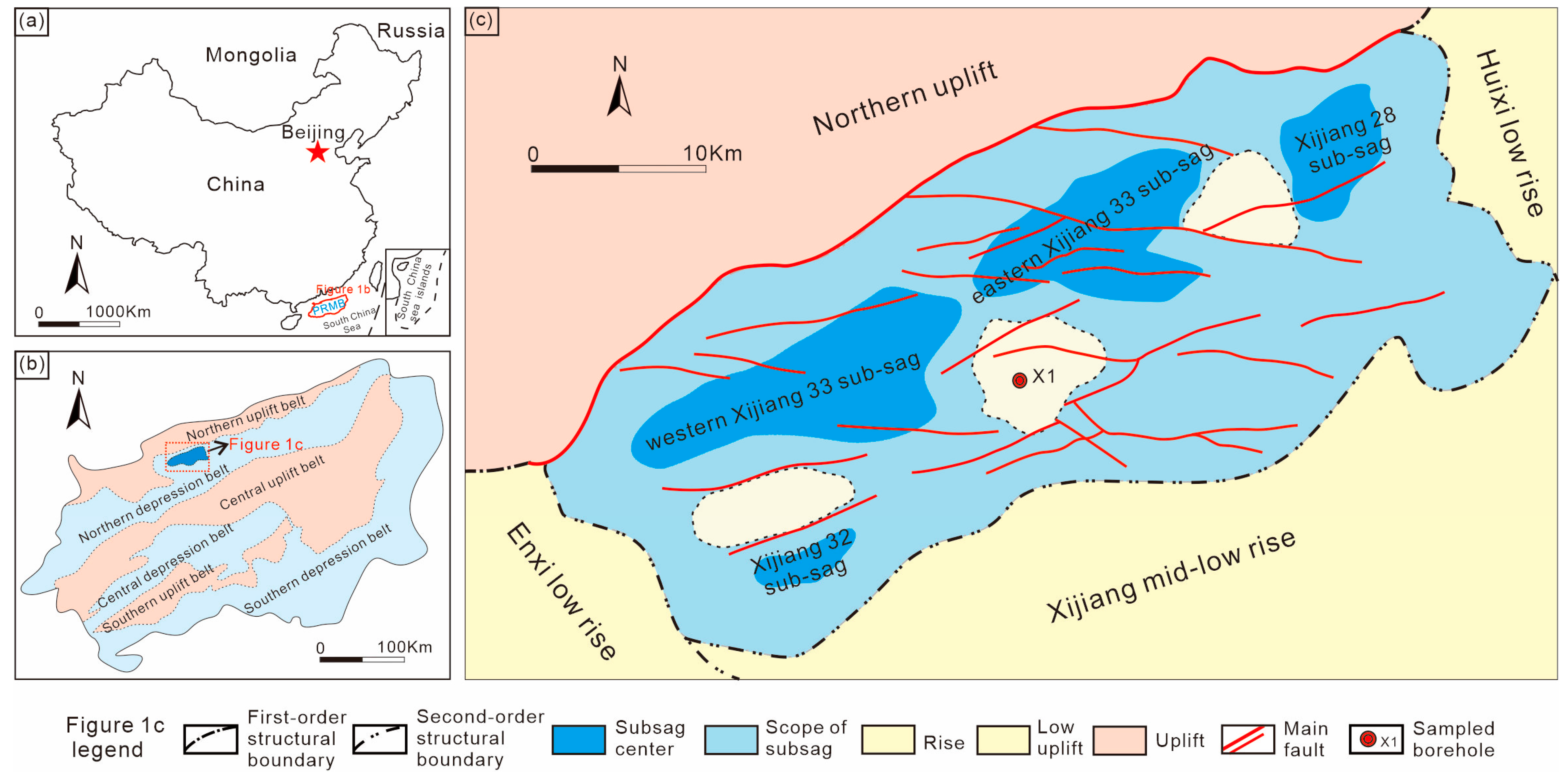
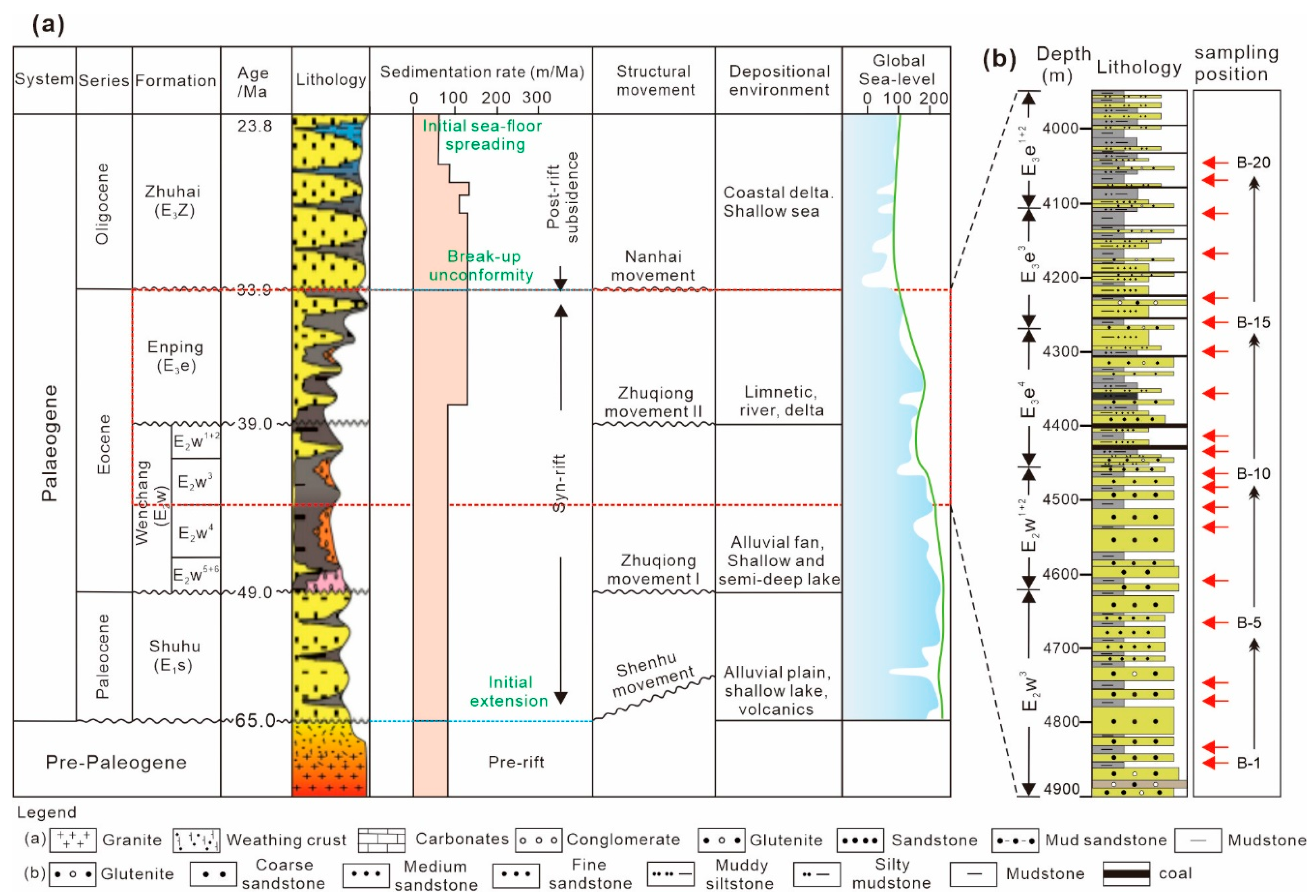


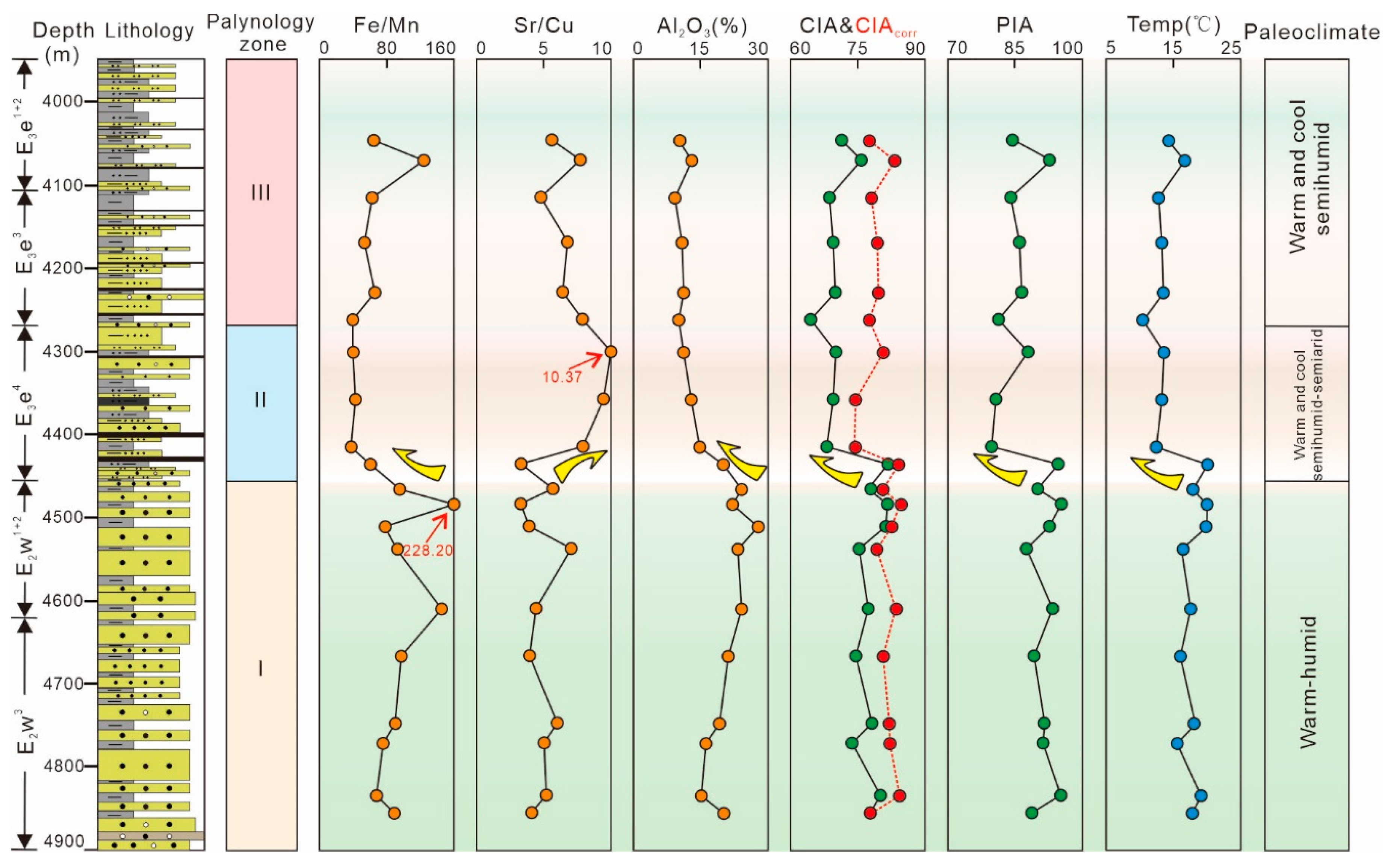
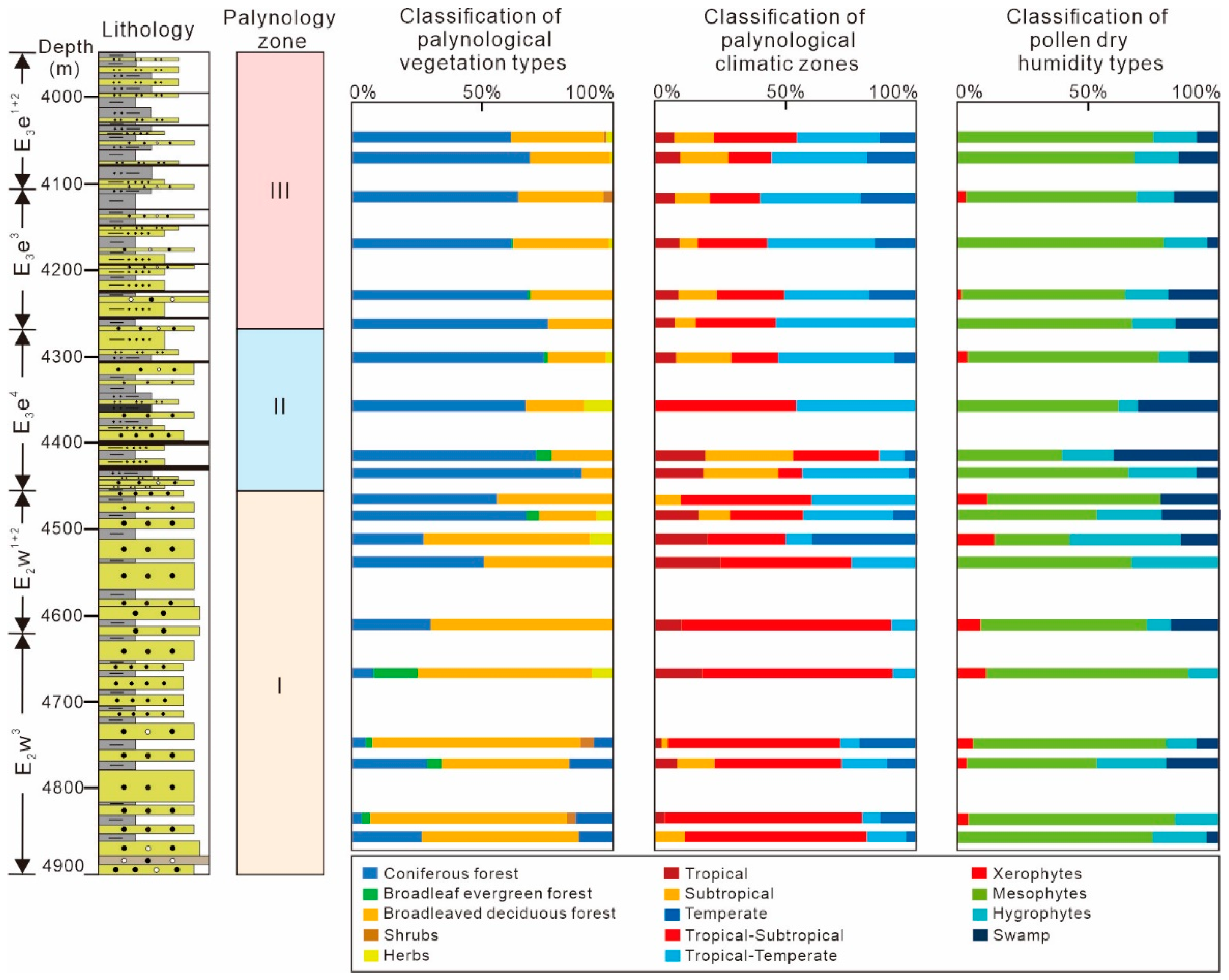
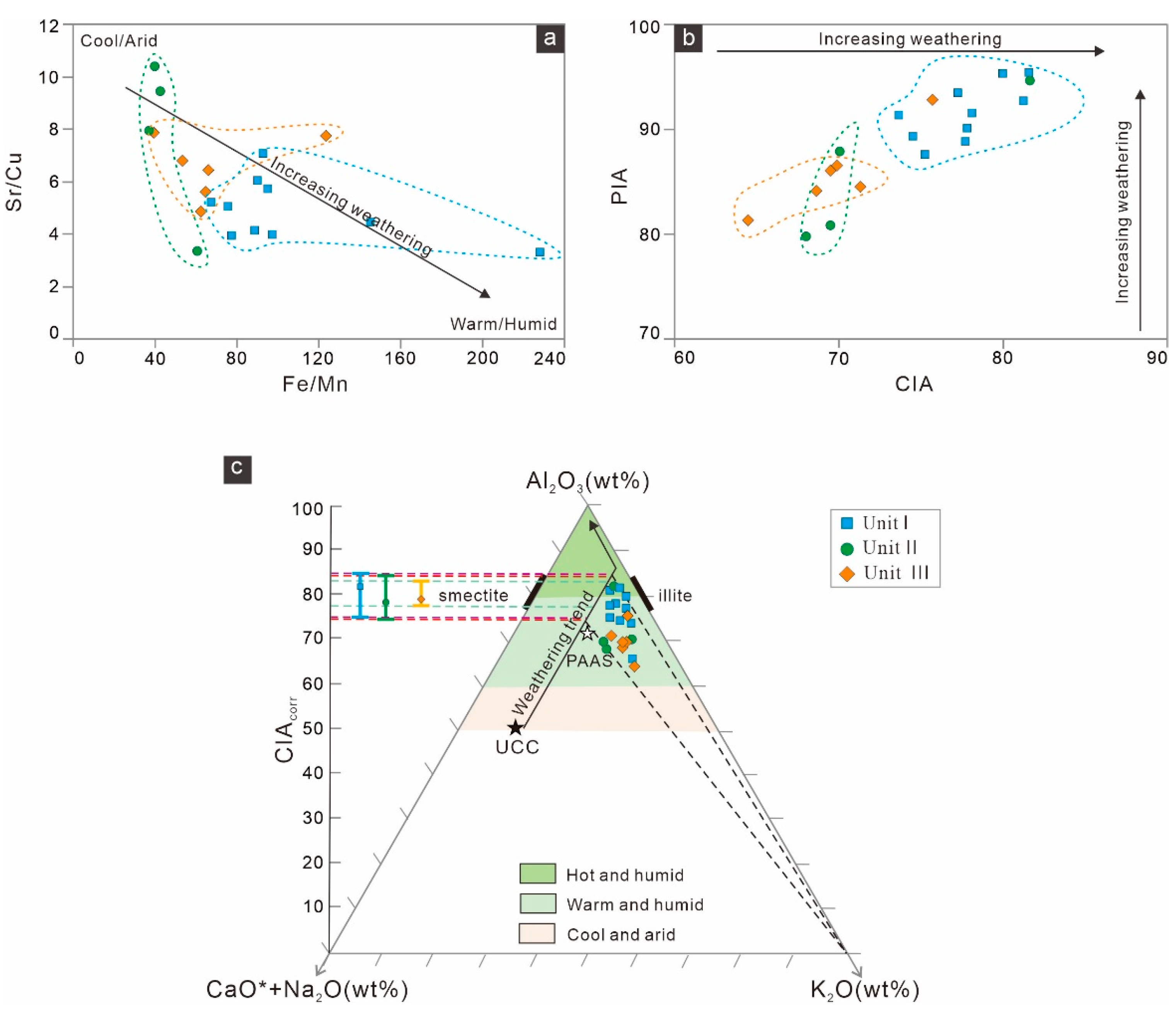

| Sporopollen | Existing Relative | Vegetation Type | Temperature Zone Type | Dry Humidity Type | Sporopollen | Existing Relatives | Vegetation Type | Temperature Zone Type | Dry Humidity Type |
|---|---|---|---|---|---|---|---|---|---|
| Angiosperm | Pteridophyte | ||||||||
| Magnolipollis | Magnoliaceae | DBLF | Tro-Sub | Mesophytes | Cyathidites | Cyatheaceae | EBLF | Tropical | Mesophytes |
| Tricolpopollenites | Hamamelidaceae? | DBLF | Tro-Sub | Mesophytes | Deltoidospora | Polypodiopsida | Herb | Tro-Sub | Hygrophytes |
| Quercoidites | Quercus | DBLF | Tro-Sub | Mesophytes | Gleicheniidites | Gleicheniaceae? | Herb | Tro-Sub | Hygrophytes |
| Ulmoideipites | Planera | DBLF | Tro-Sub | Mesophytes | Osmundacidites | Osmundaceae? | Herb | Tro-Tem | Hygrophytes |
| Rutaceoipollis | Rutaceae | DBLF | Tro-Sub | Mesophytes | Lygodioisporites | Lygodiaceae | Herb | Tro-Sub | Hygrophytes |
| Cyrillaceaepollenites | Castanea | DBLF | Tro-Tem | Mesophytes | Polypodiaceaesporites | Polypodiaceae | Herb | Tro-Sub | Swamp |
| Sapindaceidites | Sapindaceae | DBLF | Tro-Sub | Mesophytes | Gymnosperm | ||||
| Betulaepollenites | Betulaceae? | DBLF | Temperate | Mesophytes | Abietineaepollenites | Pinus | CF | Tro-Tem | Mesophytes |
| Momipites | Corylus | Shrub | Temperate | Mesophytes | Pinuspollenites | Pinus | CF | Tro-Tem | Mesophytes |
| Ostryoipollenites | Ostrya | DBLF | Temperate | Mesophytes | Piceaepollenites | Picea | CF | Temperate | Mesophytes |
| Caryapollenites | Carya | DBLF | Tro-Sub | Mesophytes | Cedripites | Cedrus | CF | Subtropical | Mesophytes |
| Alnipollenites | Alnus | DBLF | Temperate | Hygrophytes | Podocarpidites | Podocarpus | CF | Tropical | Hygrophytes |
| Pterocaryapollenites | Pterocarya | DBLF | Temperate | Hygrophytes | Inaperturopollenites | Taxodiaceae | CF | Subtropical | Swamp |
| Ulmipollenites | Ulmus | DBLF | Tro-Tem | Mesophytes | Laricoidites | Larix | CF | Tro-Tem | Mesophytes |
| Celtispollenites | Celtis | DBLF | Tro-Tem | Xerophytes | Taxodiaceaepollenites | Taxodiaceae | CF | Subtropical | Swamp |
| Juglanspollenites | Juglans | DBLF | Temperate | Mesophytes | Ephedripites | Ephedra | Shrub | Temperate | Xerophytes |
| Liquidambarpollenites | Liquidambar | DBLF | Tro-Sub | Mesophytes | Cycadopites | Cycadaceae | EBLF | Tropical | Mesophytes |
| Potamogetonacidites | Potamogeton | Herb | Tro-Tem | Hygrophytes | |||||
Disclaimer/Publisher’s Note: The statements, opinions and data contained in all publications are solely those of the individual author(s) and contributor(s) and not of MDPI and/or the editor(s). MDPI and/or the editor(s) disclaim responsibility for any injury to people or property resulting from any ideas, methods, instructions or products referred to in the content. |
© 2023 by the authors. Licensee MDPI, Basel, Switzerland. This article is an open access article distributed under the terms and conditions of the Creative Commons Attribution (CC BY) license (https://creativecommons.org/licenses/by/4.0/).
Share and Cite
Peng, G.; Chen, W.; Jia, P.; Luo, M.; He, Y.; Jin, Y.; Xu, C.; Shan, X. Middle-Late Eocene Climate in the Pearl River Mouth Basin: Evidence from a Palynological and Geological Element Record in the Xijiang Main Subsag. Minerals 2023, 13, 374. https://doi.org/10.3390/min13030374
Peng G, Chen W, Jia P, Luo M, He Y, Jin Y, Xu C, Shan X. Middle-Late Eocene Climate in the Pearl River Mouth Basin: Evidence from a Palynological and Geological Element Record in the Xijiang Main Subsag. Minerals. 2023; 13(3):374. https://doi.org/10.3390/min13030374
Chicago/Turabian StylePeng, Guangrong, Weitao Chen, Peimeng Jia, Ming Luo, Ye He, Yaoyao Jin, Chuan Xu, and Xuanlong Shan. 2023. "Middle-Late Eocene Climate in the Pearl River Mouth Basin: Evidence from a Palynological and Geological Element Record in the Xijiang Main Subsag" Minerals 13, no. 3: 374. https://doi.org/10.3390/min13030374




